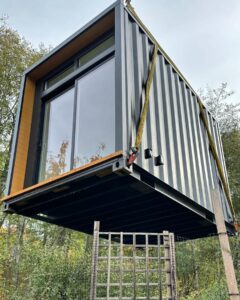
The Green Debate: Prefab Homes vs. Traditional Construction
About the Environmental Impact
In recent years, the construction industry has been undergoing a significant transformation driven by the increasing demand for sustainable and eco-friendly housing solutions. Two prominent contenders in this green revolution are prefab homes and traditional construction methods.
For this reason, Green City Times decided to delve into the environmental impact of these two approaches, analyzing their strengths and weaknesses to determine which is the more environmentally friendly option.
Prefab Homes: A Green Revolution?
Prefab homes, also known as modular or off-site construction, involve assembling building components in a factory setting and then transporting them to the construction site for final assembly.
Proponents of prefab homes argue that this method is more environmentally friendly than traditional construction for several reasons:
1. Resource Efficiency:
Prefab homes are built with precision in a controlled factory environment, reducing material waste significantly. Traditional construction, on the other hand, often results in excess materials being discarded at the construction site.
Prefab manufacturers optimize material usage, leading to minimal waste generation.
2. Energy Efficiency:
Prefab homes are designed to be energy-efficient from the ground up. The controlled manufacturing environment allows for the integration of advanced insulation and energy-efficient technologies. This can result in reduced energy consumption over the lifecycle of the building compared to traditionally constructed homes.
3. Reduced Construction Time:
The faster construction timeline of prefab homes can contribute to lower energy consumption and reduced environmental impact. Traditional construction projects, with their longer duration, typically require more energy for equipment, transportation, and on-site activities.
Traditional Construction: Environmental Risk?
While traditional construction methods have been the backbone of the building industry for centuries, their environmental impact has come under scrutiny in the face of the growing sustainability movement.
1. Construction Waste:
One of the major drawbacks of traditional construction is the significant amount of waste generated at the construction site. Cut-offs, excess materials, and packaging contribute to landfills, posing environmental challenges. In contrast, prefab construction’s streamlined process minimizes on-site waste, promoting a more sustainable approach.
2. Energy Consumption:
Traditional construction often involves on-site activities that require heavy machinery and energy-intensive processes. The transportation of materials and the use of energy-hungry equipment contribute to a higher carbon footprint. Prefab homes, with their factory-built components, can potentially reduce on-site energy consumption and associated emissions.
3. Habitat Disruption:
Traditional construction can disrupt local ecosystems and habitats, leading to deforestation and loss of biodiversity. Prefab homes, being manufactured off-site, have the potential to mitigate these disruptions by minimizing on-site activities and reducing the need for extensive land use.
For those looking to explore environmentally conscious modular building options, West Coast Container Homes, a Vancouver Island-based company, stands out as a noteworthy player committed to both the environment and the people. Their dedication to modular construction aligns with the principles of resource efficiency, reduced waste, and energy efficiency highlighted in the prefab home discussion. If you’re interested in exploring innovative and eco-friendly housing solutions, consider learning more about West Coast Container Homes at westcoastcontainerhomes.ca
Ultimately, whether choosing prefab homes or traditional construction, it is essential for individuals, builders, and policymakers to weigh the environmental impact against project-specific considerations. The evolving landscape of the construction industry presents an opportunity to shape a greener and more sustainable future, where innovative companies like West Coast Container Homes play a vital role in leading the way towards environmentally responsible building practices.